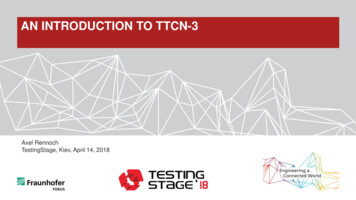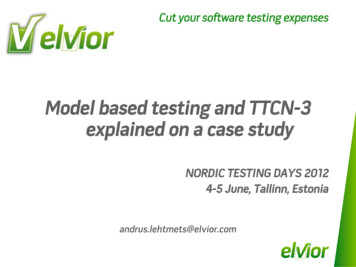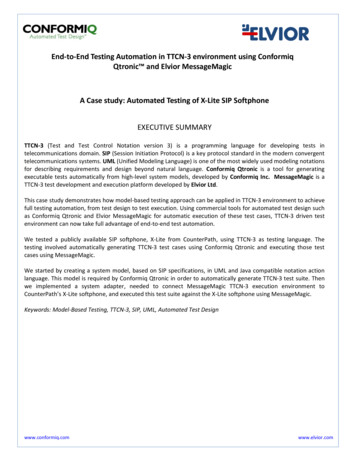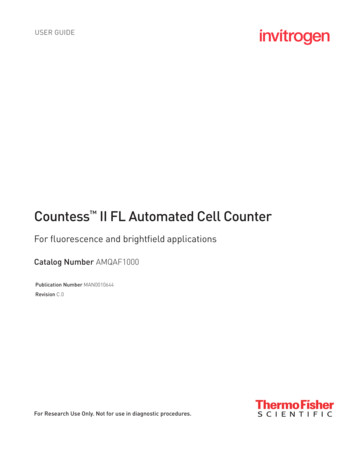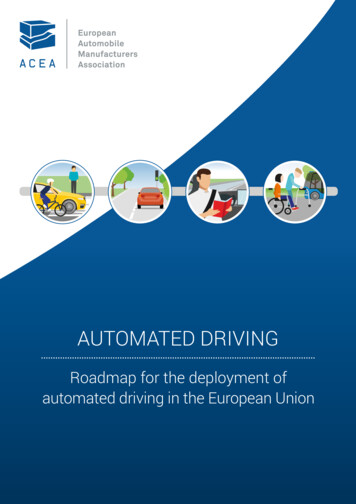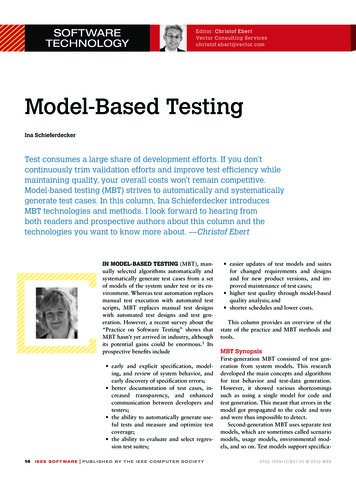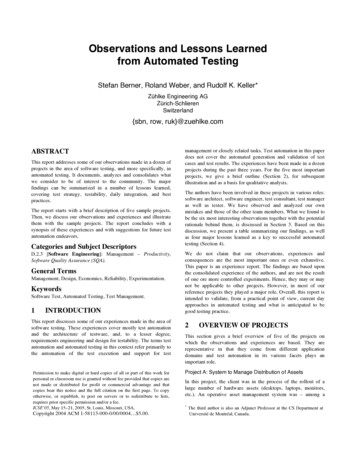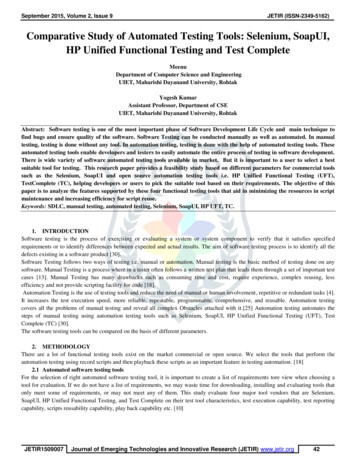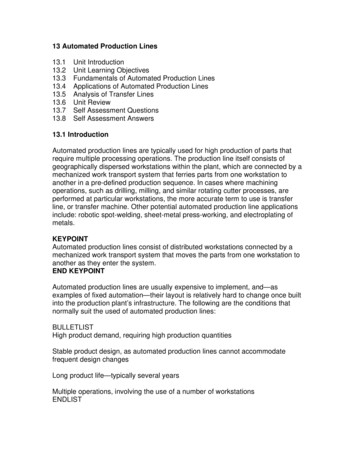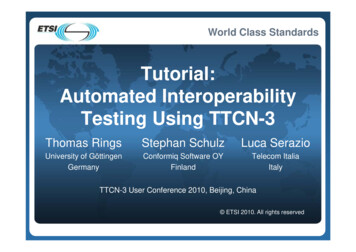
Transcription
World Class StandardsTutorial:Tt i lAutomated InteroperabilityTestingg Usingg TTCN-3Thomas RingsStephan SchulzLuca SerazioUniversityUiit off GöttingenGöttiGermanyConformiqCfi SoftwareS ftOYFinlandTelecomTlItItalialiItalyTTCN-3 User Conference 2010, Beijing, China ETSI 2010.2010 All rights reserved
World Class StandardsAcknowledgements Specialists Taskforce (STF) 370 Developed the presented materials Team of 12 specialists with various background from industry andacademia WorkW k startedt t d ini FebruaryF b2009 andd endsd ini JulyJ l 2010 Committee for Methods for Testing and Specification (MTS) at theEuropeanpTelecommunications Standards Institute (ETSI)() Initiation, guidance and monitoring of the project STF 370 has been funded in part by the European Commission(EC) 2008 ICT Standardisation Action Plan SA/ETSI/2008SA/ETSI/2008-10102
World Class StandardsOutline1. Methodology and Framework for AutomatedInteroperability Testing2. Development Process for an Interoperability TestSystem3
World Class StandardsInteroperability & Interoperability Testing “Interoperability is the ability of two systems to interoperate usingthe same communication protocol”protocol Context of Complex and distributed systems Multi-vendor, multi-network, multi-service environment Interoperability test events (e.g. ETSI Plugtest) Goals of automated interoperability testing Assure interoperability Assess and validate that systems follow standards Assess and validate standards4
World Class StandardsMotivation for a Methodology (1/2)“Interoperability is the ability of two systems to interoperate usingthe same communication protocol” Provide users a specific End toEnd (E2E) functionality/service Exchange information acrossstandardized interfaces E2E functional testing Conformance checks5
World Class StandardsMotivation for a Methodology (2/2)E2E testing may require complexset up can verify correctservice provision toendd users does not ensureadherence to standardspecificationspConformancetesting can be expensive(lots of tests) can not guaranteesystem interoperabilityi ll forf thethespeciallyapplication layerSUTUserAEUTAEUTBUserBC fConformancechecksh kE2E functionalityEUT: Equipment Under TestSUT: System Under TestNeed for a methodologyto enable automatedinteroperability testingwith conformancechecking6
World Class StandardsVerdicts in Interoperability Testing E2E interoperability verdict Pass: all EUTs interoperateas required by the test Fail: at least one EUT doesnot interoperate as requiredby the testSUTUserAEUTAEUTBUserB Conformance verdict Pass: Fulfils the conformancetest objective Fail: non-conformance to anormative requirement Inconclusive: neither a pass nor afail verdict can be givenConformance checksE2E functionality7
World Class StandardsAutomation of Interoperability Testing (1/2) Testing tasks that canbe automated Configuration of EUTs Monitoring of relevantstandardized interfaces Emulation of equipment Test execution Degree of possible automation Ideally all the tasks mentionedabove should be automated Usually automation of a subsetSUTUserAEUTAEUTBUserBI t fInterfaceconformancefchecksh kE2E functionalityEUT: Equipment Under TestSUT: System Under Test8
World Class StandardsAutomation of Interoperability Testing (2/2) Possible limitations Accessibility of SUT interfaces Complexity or cost of implementing interface access andchecks UnstableU t bl specificationsifi ti Benefits Reduces time needed for test execution and evaluationAvoids repetitive manual activitySSavescostst relatedl t d tot humanhexpertst andd testt t bedb d occupationtiReduces time to market9
World Class StandardsA Framework for Automated Interoperability TestingMeans offMInteroperabilityTestingTest OracleTest CoordinatorApplication SupportNodesSUTEUT 2IInterfacet fMonitorEUT 1EquipmentUserEUT NInterconnectingNetworkConfiguration interfaceMonitoring interfaceStimulating interface10
World Class StandardsOutline1. Methodology and Framework for AutomatedInteroperability Testing2. Development Process for an Interoperability TestSystem11
World Class StandardsDevelopment Process for an Interoperability Test System Language independent In this tutorialtutorial, explained and exemplified with specifictechnologies IP Media Subsystem (IMS) Testing and Test Control Notation Version 3 orkInteroperabilityT t SystemTestS tDesignDefine TestConfigurationLimitationsAbstract Test Suite (ATS)Specify Test CasesTestArchitectureTestDescriptionsExecutable Test Suite (ETS)ValidateDefine e odec andAdaptation Functions12
World Class StandardsIntroduction to IMS IMS IP Multimedia Subsystem 3GPP standard One of the key enablers of next generation networks Access independent plattform A peer-to-peer architecture Can be split into user, control and service layer Signalling mainly based on the Session Initiation Protocol (SIP) Call Session Control Function (CSCF) SIP servers or proxies used to process SIP signaling packets in theIMS.13
World Class StandardsIMS Core Networks Interfaces between logical entities are standardizedIMS Core NetworkHome SubscriberServer (HSS)UserUserEquipmentUserEquipmentEquipmentq UserpE iEquipmenttGmProxy (P)CSCFServing (S)CSCFInterrogating (I)CSCFInterconnectionBorder CF (IBCF)ISCMwApplicationSServerOther IMSCoreNetworks14
World Class StandardsIntroduction to TTCN-3Source: www.ttcn-3.org Internationally standardized testing languageDeveloped and maintained by the ETSI Technical Committee MTSSpecifically designed for testing and certificationCan be appliedppto a varietyy of applicationppdomains and typesyp oftesting Proven to work in very large and complex industrial tests, e.g., of3G network elements TTCN-3 test suites for IMS, LTE and SIP15
World Class StandardsTTCN-3Conceptual Test System Architecture The test system architecture is standardized via two interfaces TTCN-3 Control Interface (TCI) TTCN-3 Runtime Interface (TRI)Test System UserTest Logging (TL)CodecComponeentHandlinngTCITest Contol (TC)TTCN-3 Abstract Test Suite (ATS)System Adapter (SA)Platform Adapter (PA)TRISystemyUnder Test ((SUT))16
World Class StandardsDevelopment of Interoperability Test Systems in orkInteroperabilityTest SystemDesignDefine TestConfigurationLimitationsAbstract Test Suite (ATS)Specify Test CasesTestDescriptionsTestArchitectureExecutable Test Suite (ETS)ValidateDefine rmanceCheckRepositoryDefine TestParametersImplementCodec andAdaptation Functions17
World Class StandardsAbout ETSI’s Interoperability Testing Framework A set of guidelines how to specify interoperability tests Realizes concepts and general architecture defined in the ETSIautomated Interoperability Testing (IOT) methodology in TTCN-3 Separates conformance and interoperability verdict management Supports live vs. offline interoperability test executionCapture ModeofflineliveMessage checkingPerformed on trafficcapture files aftertestinggPerformed on live captureduring testingEquipmentoperationDisabledmanually or automatically18
World Class StandardsAbout ETSI’s Interoperability Testing Framework Basis for test component type, test interface, and test parameterdefinition Can be implemented in a library based design Libiot library basic functionalities of IOT entities, i.e., test coordinator, equipment user,interface monitor, test oracle19
World Class StandardsA Framework for Automated Interoperability TestingMeans offMInteroperabilityTestingTest OracleTest CoordinatorApplication SupportNodesSUTEUT 2IInterfacet fMonitorEUT 1EquipmentUserEUT NInterconnectingNetworkConfiguration interfaceMonitoring interfaceStimulating interface20
World Class StandardsInteroperability Testing FrameworkTest Entities Definitionstype component OracleServer extends ServerSyncComp {port VerdictPort vPort;p;var VerdictType vc e3e verdict : {none, "init"};var VerdictType vc conf verdict : {none, "init"};}type component OracleClient extends ClientSyncComp {port VerdictPort vPort;}type component TestCoordinator extends OracleServer {var ComponentIdList vcvc compIds;compIds;port AdapterConfigPort acPort;}21
World Class StandardsA Framework for Automated Interoperability TestingMeans offMInteroperabilityTestingTest OracleTest CoordinatorApplication SupportNodesSUTEUT 2IInterfacet fMonitorEUT 1EquipmentUserEUT NInterconnectingNetworkConfiguration interfaceMonitoring interfaceStimulating interface22
World Class StandardsInteroperability Testing FrameworkTest Entities Definitionstype component EquipmentUser extends OracleClient{port EquipmentAccessPortpq peaPort;;timer t equipment;}type component InterfaceMonitor extends OracleClient {timer tc wait : PX MAX MSG WAIT;var charstring vc interfaceName : "UNDEFINED";port AdapterConfigPort acPort;}23
World Class StandardsInteroperability Testing FrameworkTest Parameters Libraries are customized byy settingg test parametersp In the case of TTCN-3: module parameters Configurationginformation for each EUT IP address(es), port(s), domain name Time related parameters Timeout or duration time Test session pairing parameters Test case specifications independence of specific EUTconfiguration information24
World Class StandardsDevelopment of Interoperability Test Systems in PracticePrerequisites and kInteroperabilityTest SystemDesigngDefine TestConfigurationLimitationsAbstract Test Suite (ATS)Specify Test CasesTestArchitectureTestDescriptionsExecutable Test Suite ((ETS))ValidateDefine e odec andAdaptation Functions25
World Class StandardsTest ArchitectureExample: Interworking IMS Core Networks A test architecture is an abstract description of logical entities aswell as their interfaces and communication links involved in a testIMS Core A (EUT A)IMS Core B (EUT B)Home SubscriberServer (HSS)UserUEquipment AP-CSCFHome SubscriberServer pment BI-CSCFMw26
World Class StandardsDevelopment of Interoperability Test Systems in PracticePrerequisites and kInteroperabilityTest SystemDesigngDefine TestConfigurationLimitationsAbstract Test Suite (ATS)Specify Test CasesTestArchitectureTestDescriptionsExecutable Test Suite ((ETS))ValidateDefine e odec andAdaptation Functions27
World Class StandardsInteroperability Test Descriptions (1/2) Ideally unambiguous, informal descriptions of test cases usuallywritten in English prose Capture All equipment required for a testPre-conditions of a testEquipment operation and observation during a testProtocol messages or procedures to be checked An interoperability test description is derived from and includesan interoperability test purpose CCan also include conformanceftest purposes Interoperability tests with conformance checks28
World Class StandardsInteroperability Test DescriptionsExample: IMS Call Cancelation by Calling UserInteroperability Test DescriptionIdentifier:IOP TP:Test Architecture:Specification ReferencePre-test conditions:TD IMS CALL 0014IMS network handles correctly cancels calling user call before its establishmentInterworkingg IMS Core Networks (CF INT CALL)TS 124 229 [1], clause 5.4.3.2 ¶49 Home Subscriber Server (HSS) of IMS A and of IMS B is configured according to table 1 UE A is registered in IMS A using any user identity UE B is registered in IMS B using any user identityTest Sequence:Step1User A calls User B2Verify that User B is informed of incoming call of User A3Verify that User A is informed that UE B is ringing4User A cancels the call, before User B answers or before network timeout5Verify that user B is informed that call has been cancelled6Verify that user A is informed that call is terminatedConformance Criteria:Check1TP IMS 5107 03 in CFW step 16 (CANCEL):ensure that {when { UE A sends CANCEL to UE B }then { IMS B receives the CANCELcontaining no Route headerindicating the S-CSCF SIP URI of IMS A }}29
World Class StandardsTest SequenceUE AIMS BIMS AUE BCall User BCall User BCall User BRingingCancel CallCancel CallCancel CallCall canceledC ll tterminatedCalli t d 30
World Class StandardsInteroperability Test DescriptionsExample: IMS Call Cancelation by Calling UserInteroperability Test DescriptionIdentifier:IOP TP:Test Architecture:Specification ReferencePre-test conditions:TD IMS CALL 0014IMS network handles correctly cancels calling user call before its establishmentInterworkingg IMS Core Networks (CF INT CALL)TS 124 229 [1], clause 5.4.3.2 ¶49 Home Subscriber Server (HSS) of IMS A and of IMS B is configured according to table 1 UE A is registered in IMS A using any user identity UE B is registered in IMS B using any user identityTest Sequence:Step1User A calls User B2Verify that User B is informed of incoming call of User A3Verify that User A is informed that UE B is ringing4User A cancels the call, before User B answers or before network timeout5Verify that user B is informed that call has been cancelled6Verify that user A is informed that call is terminatedConformance Criteria:Check1TP IMS 5107 03 in CFW step 16 (CANCEL):ensure that {when { UE A sends CANCEL to UE B }then { IMS B receives the CANCELcontaining no Route headerindicating the S-CSCF SIP URI of IMS A }}31
World Class StandardsDevelopment of Interoperability Test Systems in PracticePrerequisites and kInteroperabilityTest SystemDesigngDefine TestConfigurationLimitationsAbstract Test Suite (ATS)Specify Test CasesTestArchitectureTestDescriptionsExecutable Test Suite ((ETS))ValidateDefine e odec andAdaptation Functions32
World Class StandardsLimitationsExample: IMS Core Networks Authentication and security Accessibilityy Equipment configuration and operationIMS Core A (EUT A)Home SubscriberServer (HSS)UserEquipment erOther IMSCoreNetworks33
World Class StandardsDevelopment of Interoperability Test Systems in PracticeInteroperability Test kInteroperabilityTest SystemDesigngDefine TestConfigurationLimitationsAbstract Test Suite (ATS)Specify Test CasesTestArchitectureTestDescriptionsExecutable Test Suite ((ETS))ValidateDefine e odec andAdaptation Functions34
World Class StandardsInteroperability Test DesignGeneral Guidelines Use naming conventions Use modularization Library concept Develop function design Abstract handling of proprietary interfaces Configure message skipping in monitoring Manage of EUT interface information Document code35
World Class StandardsDevelopment of Interoperability Test Systems in PracticeInteroperability Test kInteroperabilityTest SystemDesigngDefine TestConfigurationLimitationsAbstract Test Suite (ATS)Specify Test CasesTestArchitectureTestDescriptionsExecutable Test Suite ((ETS))ValidateDefine e odec andAdaptation Functions36
World Class StandardsTest Configuration: Abstract PortMappings/Connections Test System Interface (TSI) AdAdaptert configurationfitiportt(acPort) Data port (dPort) Equipment access port (eaPort) IMS Test Coordinator acts asMain Test Component (MTC) IMS coordinationdi iport (icpPort)(i P )for forwarding messages to MTC Verdict port (vPort) forcommunicating local verdictsTest System Interface (TSI)acPortdPortacPortdPortvPorteaPortIMS EquipmentUservPorti P ticpPortvPortP tIMS Interface MonitoricpPortacPortP teaPortIMS Test Coordinator37
World Class StandardsTest Configuration A concrete instance of a test architecture defined onthe basis of test entities, communication links andtheir connection Identifies EUTs, monitor points, and test entities Defines entity instance which should realize thefunctionality of one or more test entity types38
World Class StandardsTest ConfigurationExample: Interworking IMS Core NetworksSUTUserEquipmentq pAGmacPorteaPortEUT A:IMS Core NetworkdPortMwacPortIMS InterfaceMonitorvPortGm A icpPortEUT B:IMS Core er BeaPortEquipmentUservPortIMS AdPorteaPorticpPorteaPorteaotTest SystemUserEquipmentq pBIMS InterfacevPort MonitorGm BicpPortMwEquipmentUservPortUser AacPortdPortIMS InterfaceMonitorvPortGmIMS TestCoordinatorEquipmentoperation interfaceEquipmentvPort UserIMS BControlinterfaceSIPinterface39
World Class StandardsTest ConfigurationExample: IMS IOT with TTCN-3typeyp componentpIotSystemInterfacey{// systemycomponentpport DataPort dPort;port EquipmentAccessPort eaPort;port AdapterConfigPort acPort;}type component ImsInterfaceMonitorextends InterfaceMonitor {port DataPort dPort;portt ImsCoordinationPortdiiiicpPort;}40
World Class StandardsTest ConfigurationExample: IMS IOT with TTCN-3type port ImsCoordinationPortiimessage {inout SipMessage;}// Test Configuration: Interworking IMS CoreNetworkstype record CF INT CALL {ImsInterfaceMonitor gmA,ImsInterfaceMonitor mw,,ImsInterfaceMonitor gmB optional}41
World Class StandardsDevelopment of Interoperability Test Systems in PracticeInteroperability Test kInteroperabilityTest SystemDesigngDefine TestConfigurationLimitationsAbstract Test Suite (ATS)Specify Test CasesTestArchitectureTestDescriptionsExecutable Test Suite ((ETS))ValidateDefine e odec andAdaptation Functions42
World Class StandardsMessage StructuresExample: TTCN-3 Types for a SIP Canceltype record Request { //SIP Request from IETF RFC rmsgHeader,MessageBodygymessageBodygy optional,pPayloadpayload optional}type record RequestLine {type enumerated Method {Methodmethod,ACK E,SipUrlrequestUrirequestUri,BYE EBYE E,charstringsipVersionCANCEL E,}INVITE E, // .}43
World Class StandardsDevelopment of Interoperability Test Systems in PracticeInteroperability Test kInteroperabilityTest SystemDesigngDefine TestConfigurationLimitationsAbstract Test Suite (ATS)Specify Test CasesTestArchitectureTestDescriptionsExecutable Test Suite ((ETS))ValidateDefine e odec andAdaptation Functions44
World Class StandardsTest Parameter Examples Specify EUT interface information IP addresses and ports of interfaces, domain names, user identities Specify time limit parameter Enable and disable observations of specific interfaces Interface(s) may not be accessible Enable/disable execution of associated monitor components in test Select capture mode for lower tester adapter, i.e., offline or live Configure general lower test adapter settings Dependent on capture mode selection45
World Class StandardsTest Parameters in TTCN-3Configuration of EUT interface information A module parameter captures all information for each supportedinterface of each product participating in an interoperability eventmoduleparmodlepar ProductListP d tLi t PXPX PRODUCTSPRODUCTS : {{ // productIndex 0productName : “Super IMSCore”,monitorInterfaces: {{ interfaceName: “Mw”,interfaceInfo: {IpInterfaceInfo: {{ domainName : “pcscf.core.etsi”,IpAddress: “192.86.1.97”,portNumbers: {5060}},{ domainName : “icscf.core.etsi”,IpAddress: “192.86.1.98”,portNumbers: {5060}}}}}}}}46
World Class StandardsThe Development of an Interoperability Test System inPractice – The Abstract Test Suite InteroperabilityTest SystemDesigngDefine TestConfigurationLimitationsAbstract Test Suite (ATS)Specify Test CasesTestArchitectureTestDescriptionsExecutable Test Suite ((ETS))ValidateDefine e odec andAdaptation Functions47
World Class StandardsAbstract Test Suite (ATS) Specification Specific TTCN-3 definitions test configurationgmanagement,g, test case statements,, testpurpose checking functions Imports interoperability testing framework libraries Imports (or defines) technology specific libraries (e.g.protocols libraries) ATS consists of modules: TestConfiguration, TestSystem, TypesAndValues Functions,Functions Templates,Templates TestSteps,TestSteps TestCases,TestCases TestControl48
World Class StandardsThe Development of an Interoperability Test System inPractice – The Abstract Test Suite InteroperabilityTest SystemDesigngDefine TestConfigurationLimitationsAbstract Test Suite (ATS)Specify Test CasesTestArchitectureTestDescriptionsExecutable Test Suite ((ETS))ValidateDefine e odec andAdaptation Functions49
World Class StandardsSpecification of Test CasesThe TTCN-3 Testcase Statement Structure follows conventional test case implementation ImsTestCoordinator acts as MTC IotSystemInterface represents the abstract interface to upper andlower test adapterstestcase TC IMS CALL 0014() runs on ImsTestCoordinatorsystem IotSystemInterface {// 1. Test configuration setup// 2. Preamble// 3.3 Test body// 4. Postamble// 5. Tear down}50
World Class StandardsSpecification of Test CasesTest Configuration Setup (1/5)SUTUserEquipmentq pAGmEUT A:IMS Core NetworkIMS InterfaceMonitorMwEUT B:IMS Core NetworkUserEquipmentq pBIMS InterfaceMonitorIMS InterfaceMonitorGm AGmGm BMwEquipmentUserEquipmentUserUser AUser BEquipmentUserIMS ATest SystemLegend:MonitorinterfaceIMS TestCoordinatorEquipmentoperation interfaceEquipmentUserIMS BControlinterfaceSIPinterface51
World Class StandardsSpecification of Test CasesTest Configuration Setup (2/5) Lower test adapter is configured (e.g., for use of live mode)MTCacPortacPortSystemm generalConfigurationReq livem generalConfigurationReq livem generalConfigurationRsp successacPortacPort“General configuration succeed” 52
World Class StandardsSpecification of Test CasesTest Configuration Setup (3/5)SUTUserEquipmentq pAGmEUT A:IMS Core NetworkIMS InterfaceMonitorMwEUT B:IMS Core NetworkUserEquipmentq pBIMS InterfaceMonitorIMS InterfaceMonitorGm AGmGm BMwEquipmentUserEquipmentUserUser AUser BEquipmentUserIMS ATest SystemLegend:MonitorinterfaceIMS TestCoordinatorEquipmentoperation interfaceEquipmentUserIMS BControlinterfaceSIPinterface53
World Class StandardsSpecification of Test CasesTest Configuration Setup (4/5)MTCSystemacPortacPortvPortm SetFilterReqS tFilt RacPortacPortacPort“AdapterconfAdapterconf. successsuccess”vPortm SetFilterReqmw SetFilterRepConformance: PassvPort Mwmw SetFilterRepConformance: PassacPort GmAacPortacPort“Adapterconf. success”vPort 54
World Class StandardsSpecification of Test CasesTest Configuration Setup (5/5) After all lower test adapter configurations are completed, trafficcapture processing is started by the MTCMTCCSSystemm startTrafficCaptureReqacPortacPort acPortm startTrafficCaptureRsp anyacPort 55
World Class StandardsSpecification of Test CasesTestcase Statement: Preambletestcase TC IMS CALL 0014()runs on ImsTestCoordinatorsystem IotSystemInterface {// 1. Test configuration setup// 2. Preamble// 3. Test body// 4. Postamble// 5. Tear down}56
World Class StandardsSpecification of Test CasesInteroperability Test Description - PreambleInteroperability Test DescriptionIdentifier:IOP TP:Test Architecture:Specification ReferencePre-test conditions:TD IMS CALL 0014IMS network handles correctly cancels calling user call before its establishmentInterworkingg IMS Core NetworksTS 124 229 [1], clause 5.4.3.2 ¶49 HSS of IMS A and of IMS B is configured according to table 1 UE A is registered in IMS A using any user identity UE B is registered in IMS B using any user identityTest Sequence:Step1User A calls User B2Verify that user B is informed of incoming call of User A3Verify that user A is informed that UE B is ringing4User A cancels the call, before User B answers or before network timeout5Verify that user B is informed that call has been cancelled6Verify that user A is informed that call is terminatedConformance Criteria:Check1TP IMS 5107 03 in CFW step 16 (CANCEL):ensure that {when { UE A sends CANCEL to UE B }then { IMS B receives the CANCELcontaining no Route headerindicating the S-CSCF SIP URI of IMS A }}57
World Class StandardsSpecification of Test CasesPreamble (1/2) Successful Registration of UE A in IMS AMTCSystemUser AstarteaPorteaPortm EO Requestmw EO ResponseeaPorteaPort“UE registration successful”vPortE2E: PassvPortE2E verdict pass;done 58
World Class StandardsSpecification of Test CasesPreamble (2/2)function f userRegistration(in charstring p publicId, in charstring p privateId,i charstringinht ip pw))runs on EquipmentUser {f sendEquipmentCmd(valueof(m EO Request(c UE REGISTRATION, {p publicId,p privateId, p pw}))); // LibIot function}59
World Class StandardsSpecification of Test CasesTestcase Statement: Test Bodytestcase TC IMS CALL 0014()runs on ImsTestCoordinatorsystem IotSystemInterface {// 1. Test configuration setup// 2. Preamble// 3. Test body// 4. Postamble// 5. Tear down}60
World Class StandardsSpecification of Test CasesInteroperability Test Description – Test BodyInteroperability Test DescriptionIdentifier:IOP TP:Test Architecture:Specification ReferencePre-test conditions:TD IMS CALL 0014IMS network handles correctly cancels calling user call before its establishmentInterworkingg IMS Core NetworksTS 124 229 [1], clause 5.4.3.2 ¶49 HSS of IMS A and of IMS B is configured according to table 1 UE A is registered in IMS A using any user identity UE B is registered in IMS B using any user identityTest Sequence:Step1User A calls User B2Verify that user B is informed of incoming call of User A3Verify that user A is informed that UE B is ringing4User A cancels the call, before User B answers or before network timeout5Verify that user B is informed that call has been cancelled6Verify that user A is informed that call is terminatedConformance Criteria:Check1TP IMS 5107 03 in CFW step 16 (CANCEL):ensure that {when { UE A sends CANCEL to UE B }then { IMS B receives the CANCELcontaining no Route headerindicating the S-CSCF SIP URI of IMS A }}61
World Class StandardsSpecification of Test CasesTest Body (1/9) – Equipment Operation// 4. Test bodyf mtc userInitiateCall(v ueA, v userInfoB); // Step 1f mtc userCheckRinging(v ueB); // Step 2f tf mtc userCheckPeerIsRinging(v ueA);Ch kPI Ri i (A) // StStep 3f mtc userTriggerCancelCall(v ueA); // Step 4f mtc check TP IMS 5107 03 ggm(v( ggmA,, false);); // Check1f mtc check TP IMS 5107 03 mw(v mw, false); // Check1f mtc userCheckCallCancelled(v ueB); // Step 5f mtc userCheckCallEnded(v ueA); // Step 662
World Class StandardsSpecification of Test CasesTest Body (2/9) – Equipment Operation Successful call initiation by UE AMTCSystemUser AstarteaPorteaPortm EO Requestmw EO ResponseeaPorteaPort“UE call initiation successful”vPortE2E: PassvPortE2E verdict pass;done 63
World Class StandardsSpecification of Test CasesTest Body (3/9) – Equipment Operation Usage of a generic equipment operation function Sends a IMS UE operation command Sets local test component E2E verdict and reports it to MTCfunction f userCallInitiation(charstring p publicID)runs on EquipmentUser {f sendEquipmentCmd(valueof( // LibIot functionm EO Request(c UE CALL INITIATION, {p publicID})));}64
World Class StandardsSpecification of Test CasesTest Body (4/9) – Conformance ChecksInteroperability Test DescriptionIdentifier:IOP TP:Test Architecture:Specification ReferencePre-test conditions:TD IMS CALL 0014IMS network handles correctly cancels calling user call before its establishmentInterworkingg IMS Core NetworksTS 124 229 [1], clause 5.4.3.2 ¶49 HSS of IMS A and of IMS B is configured according to table 1 UE A is registered in IMS A using any user identity UE B is registered in IMS B using any user identityTest Sequence:Step1User A calls User B2Verify that user B is informed of incoming call of User A3Verify that user A is informed that UE B is ringing4User A cancels the call, before User B answers or before network timeout5Verify that user B is informed that call has been cancelled6Verify that user A is informed that call is terminatedConformance Criteria:Check1TP IMS 5107 03 in CFW step 16 (CANCEL):ensure that {when { UE A sends CANCEL to UE B }then { IMS B receives the CANCELcontaining no Route headerindicating the S-CSCF SIP URI of IMS A }}65
World Class StandardsSpecification of Test CasesTest Body (5/9) – Conformance Checks// 4. Test sequence / test bodyf mtc userInitiateCall(v ueA, v userInfoB); // Step 1f mtc userCheckRinging(v ueB); // Step 2f tf mtc userCheckPeerIsRinging(v ueA);Ch kPI Ri i (A) // StStep 3f mtc userTriggerCancelCall (v ueA); // Step 4f mtc check TP IMS 5107 03 ggm(v( ggmA,, false);); // Check1f mtc check TP IMS 5107 03 mw(v mw, false); // Check1f mtc userCheckCallCancelled(v ueB); /
World Class Standards Interoperability & Interoperability Testing "Interoperability is the ability of two systems to interoperate using the same communication protocolthe same communication protocol" Context of Complex and distributed systems Multi-vendor, multi-network, multi-service environment Interoperability test events (e.g. ETSI Plugtest)
